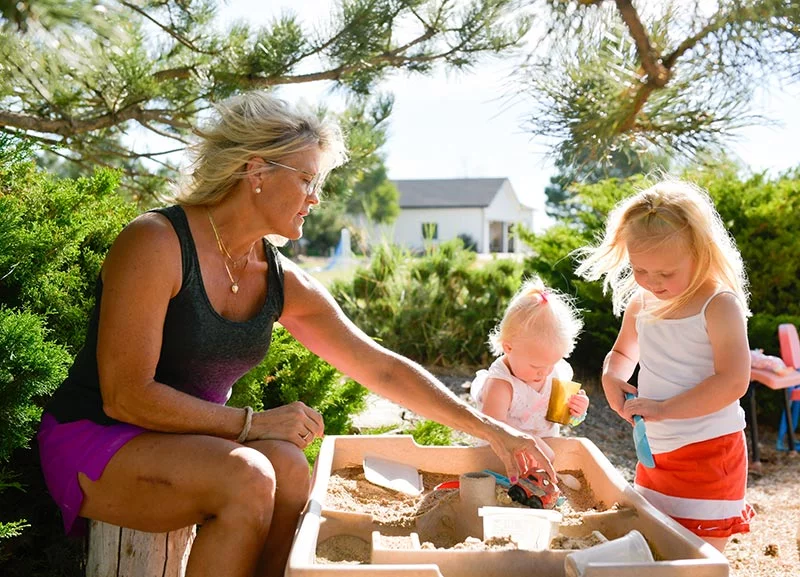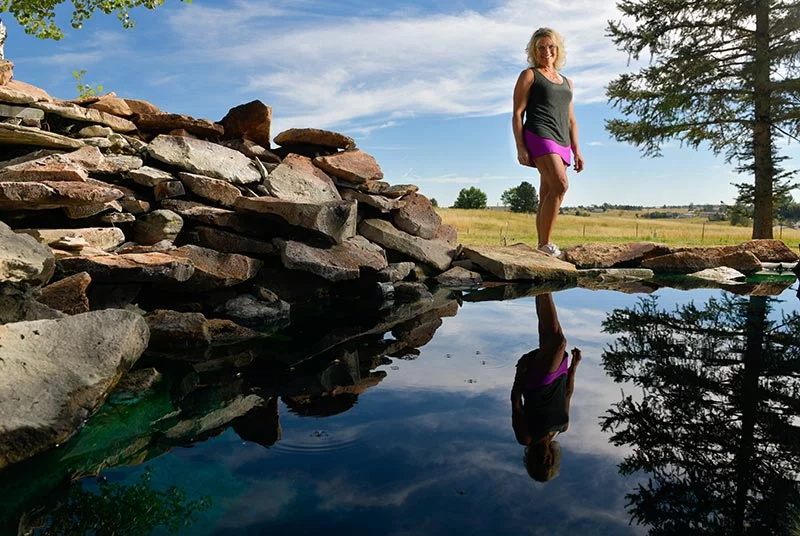
For Colorado and neighboring states, it was a first.
Never before in the region had a liver-transplant donor surgery been performed by a surgical robot. Given the robotic procedure’s proven advantages in shorter recovery time and fewer complications, the timing couldn’t have been better.
The robotic part was new for Danel Kuhlmann also. But she had donated an organ before.
In 2018, her active, healthy mother had fallen ill and ended up on dialysis for months. She needed a kidney transplant. Kuhlmann, then 49, turned out to be a match. Transplant surgeon, Dr. Thomas Pshak, performed the surgery to remove it.
Early on June 9, Pshak was again with Kuhlmann in a UCHealth University of Colorado Hospital operating room. As the bedside surgeon, he would be indispensable to the procedure. But the primary surgeon, Pshak’s colleague Dr. Trevor Nydam, sat at the controls of the Da Vinci Surgical System half a room away. Also present was Dr. Elizabeth Pomfret, who leads the University of Colorado School of Medicine’s Division of Transplant Surgery and the Colorado Center for Transplantation Care, Research and Education.
The surgery would be a team effort. While all three have done many liver transplants. She has more than two decades of experience with live-donor transplants and is expert in the surgery and the various anatomical quirks that can complicate the procedure. Pshak is the UCH transplant-team surgeon with the deepest experience with the Da Vinci system. Among other feats, he performed the state’s first robotic kidney transplant. Nydam, also a robotic-surgery expert, would be taking the lead in what the UCHealth Transplant team hoped would become the prevailing approach to liver-donor surgeries.

more thanks to the robotic surgery. Photo by Cyrus McCrimmon, for UCHealth.
Robotic liver transplants perfected overseas
The first robotic living donor hepatectomy, as it’s technically called, was done at the University of Illinois-Chicago in 2012. Its most experienced practitioners are now a long way from the Windy City. Nydam and Pshak both spent weeks in Riyadh, Saudia Arabia, in late 2022 and early 2023. There they trained on the procedure at King Faisal Specialist Hospital, where surgeons did their first such surgery in late 2018. Since 2021, all living-donor liver transplant surgeries at King Faisal Specialist Hospital – now several hundred and counting – have been done robotically.
Necessity played a big role. Cultural and religious factors limit the availability of deceased-donor organs in many Middle Eastern and Asian countries. Saudi Arabia and Korea have emerged as leaders in robotic living donor liver transplantation. In the United States, in contrast, only about 6% of liver transplants involve living donors – though the percentage is about twice that in Colorado, where UCHealth surgeons performed about three-quarters of the state’s 176 liver transplants in 2022.
Pshak says University of Colorado is in a great position to follow King Faisal’s lead in transitioning to robotic living donor liver transplant surgery. Studies have shown that the robotic surgery sharply speeds recovery – two to three weeks rather than six to eight weeks – thanks to much shorter incisions and lower infection and hernia risk, among other factors.
“If we could do living donors for livers this way, it would ultimately attract more people to donate with easier recovery and less morbidity,” Pshak said.

Double donor
But first, they had to attract that first patient. That’s where Danel Kuhlmann came in. Her experiences surrounding her mom’s kidney transplant had been life-changing.
“I was in a desperate position with my mother falling ill. I would have given anything to get her healthy,” Kuhlmann said. “There was such a sense of despair and just sadness when something like this happens to someone you love. I couldn’t imagine another family being in that position when I had that solution in me.”
So, for the second time, she decided to become a donor. She would give part of her liver to someone who needed it (her liver, which has a remarkable ability to regenerate, would grow back with time).

In late April, a match was identified – a child. During Kuhlmann’s preoperative appointment on May 25, Nydam broached the subject of robotic surgery. He talked about spending two months training in Saudi Arabia and noted that the procedure brought a quicker recovery with fewer complications. The surgeon produced his phone and shared photos. Kuhlmann was impressed, though she didn’t quite know where he was going with it. Then, she said, “He popped the question like he was asking to marry me.”
“Will you be willing to be our first robotic liver transplant donor?” Nydam asked.
She said “yes” instinctively, only later wondering if it had been a bit rash. But ultimately, she said, her gut reaction had been the right one.

“Because of my familiarity with the team there, I trust them and knew it would go well,” she said.
Superhuman capabilities
During the procedure, the Da Vinci system sent digital interpretations of Nydam’s hand and foot movements to the surgical robot. The robot removes the natural jitter of even the steadiest human hands, and its steel implements enjoy agility and precision far surpassing those of human limits – particularly in tight spaces.
The surgeon’s console provided 3-D visualization while monitors around the operating table and high on an operating room wall displayed the proceedings at the same 10X magnification that the system afforded the surgeon. The robot’s three surgical arms and camera needed only half-inch incisions each. The only traditional incision was a roughly four-inch horizontal cut low on the abdomen that was needed to extract a section from the left side of Kuhlmann’s liver.
At the foot of the operation table, Pshak changed out surgical instruments, set up suturing, and, with Pomfret, made suggestions to Nydam during a procedure that took several hours before a small section of liver landed on ice and was whisked across the Anschutz Medical Campus to Children’s Hospital Colorado, where the child’s surgeons awaited it.

‘Part of my legacy’
The immediate recovery was, as with any surgery involving anesthesia, “rough,” as Kuhlmann put it. But she recovered as quickly as Nydam said she would.
“I would honestly say that between two and three weeks out, I felt 90 to 100 percent back to normal,” she said. By early July, she taking care of granddaughters Ffion, 4, and Freya, 2, which involved a good deal of kid-lifting. As of early August, Kuhlmann says she was entirely back to normal and gardening, hiking, biking, power walking, and running.
She views being a double donor as being “part of my legacy,” As she put it.
Pshak and colleagues hope robotic surgery makes liver donation a part of others’ legacies too.
“That she came forward and was willing to give part of her liver to save this child is amazing,” Pshak said. “This is the way forward to transplant more people and save more lives.”
